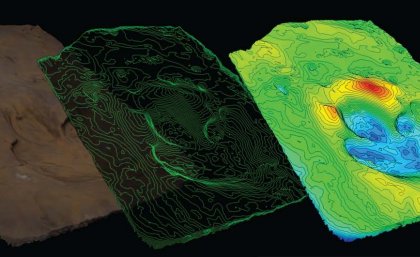-1.jpg?itok=MC7Zeg98)
Dinosaur footprints in Central Queensland’s Lark Quarry were not all caused by a dinosaur stampede, as previously thought.
University of Queensland palaeontologists used 3D modelling of the large set of footprints to show they were made by a plant-eating dinosaur and not a meat-eater, and had occurred before the tracks from the ‘stampede’ were made.
UQ School of Biological Sciences PhD graduate Dr Anthony Romilio said Lark Quarry, 110km south of Winton, had been famed for preserving the footprints of a carnivorous dinosaur that approached a mixed herd of chicken- and turkey-sized dinosaurs, causing them to stampede approximately 93 million years ago.
“All these dinosaurs were on the move, but rather than all being present during one event, the footprints were made in a series of separate events across several hours or even days,” Dr Romilio said.
“Our results show that the large dinosaur was a herbivore that crossed the area shortly before the site was covered in shallow water, while the smaller tracks occurred hours to days later.
“We also know from our previous research that some of these smaller dinosaurs were swimming.”
The researchers used a technique known as photogrammetry to digitally map each of the largest footprints in 3D.
The study’s co-author, Dr Steve Salisbury from UQ’s School of Biological Sciences, said the results showed that what actually happened at Lark Quarry about 93 million years ago might be far more interesting than the stampede theory.
“It’s definitely not a moment frozen in time, as previously believed,” Dr Salisbury said.
“By mapping pressure bulges from the large footprints, drag marks from vegetation and the small footprints dotted onto these marks, we have been able to recreate a sequence of events that took place over a period ranging from several hours to several days.”
The findings contradict the original study of the site, published in 1984, that recorded v-shaped toe impressions and inferred that the large dinosaur was a carnivore.
The new results show that the footprints have rounded toe impressions, characteristic of herbivores, and similar to herbivore tracks found across Europe and China.
The recent findings were published online in Cretaceous Research.
Lark Quarry, also known as the Dinosaur Stampede National Monument, is south of Winton in central-western Queensland and has more than 3000 dinosaur footprints.
More information about dinosaur-related research at UQ can be found here.
Media: Anthony Romilio +61 430 514 169, a.romilio@uq.edu.au)
Dr Steve Salisbury +61 7 3365 8548, +61 407 788 660, s.salisbury@uq.edu.au
Images and animated 3D models of the Lark Quarry dinosaur tracks are available from Aimee Parker +61 7 3346 1629, a.parker3@uq.edu.au
.jpg)












